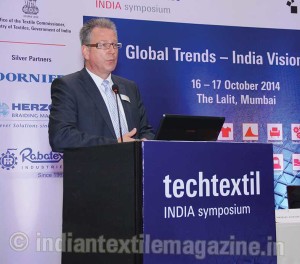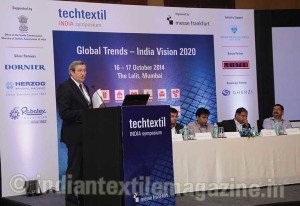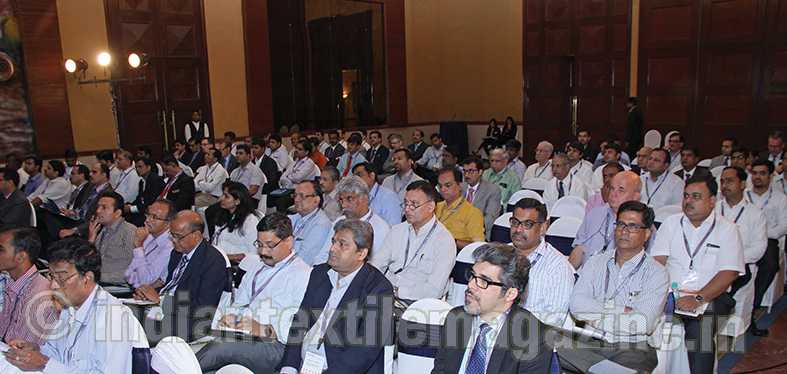Global per capita use of nonwovens to double by 2015
Techtextil India Symposium has emerged as the primary conference for highlighting the prowess of the technical textile and nonwovens sector across the globe, with the successful contact of several editions of the conference held over the past years in Frankfurt, India, the Middle East and Russia. The latest edition held in Mumbai on October 16-17, 2014, saw an eminent gathering of professionals from the industry and over 130 delegates from India and abroad.
Denoting a very positive outlook for the worldwide technical textiles market, Mr. Michael Jänecke, Director – Brand Management Technical Textiles & Textile Processing, Messe Frankfurt, in his opening address, pointed out: “Technical textiles is one of the most innovative sectors and stands among the leading five high-tech industries, in terms of growth potential. Worldwide, the sector is expected to witness growth at three to five per cent a year.”
Presenting global trends and the vast opportunities in the Indian market, the first session began with Mr. Hendrik H. van Delden, Managing Partner from Gherzi van Delden GmbH, Germany, highlighting how the evolution in manufacturing and industrial sector demands lighter technologies steering towards trends such as weight saving, high fiber and high performance fabrics.
Presenting developments in nonwovens, EDANA, the international association serving the nonwovens and related industries, pointed out that consumption of nonwovens has outpaced global textile fibre consumption and that a double-digit growth is predicted for the Indian market in the next three to four years. Moreover, global per capita consumption is likely to grow from one kilogram in 2001 to two kilograms by 2025.

With the Indian Government keen to increase the contribution of manufacturing in the economy, the local technical textiles sector is expected to grow at 20 per cent CARG over the next decade.
Speaking about how the sector can achieve this growth target, Mr. Vijaya K., Lead Consultant Corporate Advisory, ICRA Management Consulting Services Ltd., said: “Challenges related to the availability of specialty fibre and raw materials, policy and power-related issues and high transaction costs are the major growth deterrents for the sector. A re-look at the textile matrix and a multi-pronged strategy targeting the domestic market consumption pattern, export promotion, institutional demands and value-added products will ensure we achieve this growth objective.”
Aimed at bringing forward “New Developments in Fibre and Composites”, the symposium also saw front-runners in the technical textile sphere like Reliance Industries Ltd., Teijin India Pvt. Ltd., Saertex India and Leister Technologies India Pvt. Ltd. underlining innovations in specialty polyester fibers, advanced composites with non-crimp fabrics and fire-resistant composite system and technologies that optimise weld parameters.
The final session on day one ended with a progressive perspective on ‘Nonwovens industry and innovations’, wherein speakers stressed that nonwoven is a highly research-driven industry and India needs to apply a multi-disciplinary approach towards R&D in technical textiles. Backed by strong demand from disposable and durable commodities, growth in the sector will be sustained by material innovation that can conserve energy, achieve sustainability and involve high performance factors. Future opportunities will stem from integrating woven and nonwovens in wearable electronics, lighter weight components, carbon composites and glass fabrics, autonomous vehicles, energy storage, advanced materials and renewable energy. A robust system to fund business R&D can support these developments.
Industry challenges & technology developments
Day two of the conference dedicated to technical textiles development prospects offered much in terms of technology innovations and developments with speakers highlighting innovations such as resin-coated glass fabrics – a new tool for architects to design stadium roofing, pioneering concept of 2½ D braiding that combines the advantages of both 2D and 3D technologies without the disadvantages and developments in warp knitting for technical textiles.
Bringing sector specialists from consultation, manufacturing and research sides for the highly anticipated panel discussion on the ‘Technical Textile Industry – Future and Growth Outlook’, the conference mirrored concerns of the industry on how India can become a powerful force in the global technical textiles sector and match pace with dominant players like China and Japan.

The discussion saw some very interesting inputs from the panelists during which Mr. V. Jiagopal, Managing Director – India, Madhura Coats Pvt. Ltd., said that businesses need to refocus on strategies and have an export-orientation, while Mr. Utkarsh S. Trivedi, Executive Director, Neo Corp International Ltd., was of the opinion that technology transfer can provide a major boost and companies should look at joining hands with experienced international players for long-term business gains.
Pointing towards the changing attitude of the buyers, the panelists agreed that most big companies are moving away from the dependence on one supplier or country, which spells good news for Indian technical textile players with its low labor cost advantages. Introducing intelligent blends that can supplement lack of available fibres can drive growth in the right direction.
Said Mr. Seshadri Ramkumar, Professor, Nonwovens & Advanced Materials Laboratory Texas Tech University: “Product differentiation will always find markets and holds the key to developing strong customer base. Backward integration and improving lead time will further propel export business.”
Mr. Sanjay Thapliyal, President, Century Enka Ltd., added: “Focus on specialty production is important. However, players need to become quality conscious and maintain standardisation to avoid disappointment of shipping bad quality goods which can be a major deterrent for export markets.”
The final session of the two-day symposium also saw Mr. Michael Jänecke present worldwide trends and developments taking into account the big five of the technical textile market – Germany, Italy, France, the UK and Belgium.
Explaining that export was only one leg of growth, Mr. Seshadri Ramkumar, in his address, added: “Industry is not growing at the pace it should because of lack of focus within buying segments and their requirements. Sector players should concentrate on end user product requirements and bring about diversity both in terms of process and production.”
Speaking about the industry vision for the composites market, Mr. Gokul Venkataraman, Strategic Market Manager, Owens Corning, said: “Composites can effectively replace traditional materials because of its features such as fuel efficiency, non-corrosive, durability, sustainability. Wind energy is a big ticket item for composites and can prove to be a major demand driver.”
Ending on an insightful note into growth prospects of the industry, the Techtextil India Symposium laid the foundation for a successful preparation for the trade fair in 2015. With confirmations pouring in, the next edition of Techtextil India and Symposium indicates a promising outlook and will take place at the Bombay Exhbition Centre during September 24-26, 2015.
